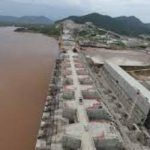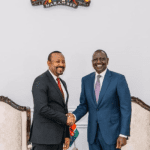Ethiopia and Egypt reported that negotiations over a massive and extremely controversial hydroelectric dam Ethiopia built on the main tributary of the Nile had again broken down without a compromise.
Following the conclusion of three days of talks in Addis Ababa, the nations laid blame on one another.
Ethiopia’s “persistent refusal” to accept any compromise, according to Egypt’s Ministry of Water Resources and Irrigation, was the main reason the negotiations failed.
Egypt was accused by the Ethiopian Foreign Ministry of erecting “roadblocks” in the talks to hinder any kind of agreement.
Sudan was also a part of the negotiations.
The countries have been trying to find an agreement for years over the $4 billion Grand Ethiopian Renaissance Dam, which Ethiopia began building in 2011.
Egypt worries that if Ethiopia doesn’t consider its needs, the dam on the Blue Nile, which is close to the Sudanese border, could have a disastrous impact on its water and agricultural supply downstream.
After joining the White Nile in Khartoum, the capital of Sudan, the Blue Nile continues through Egypt.
Egypt, which is home to more than 100 million people and is the most populous country in the Arab world, has described Ethiopia’s project as an existential threat. Ethiopia depends almost exclusively on the Nile for its water supply for agriculture.
Egypt is deeply concerned over how much water Ethiopia will release downstream from the dam and wants a deal to regulate that.
Ethiopia is using the dam to generate electricity.
Egyptian President Abdel Fattah el-Sissi and Ethiopian President Abiy Ahmed resolved in July to come to an agreement on the dam within four months. Another round of talks between the three countries in September also ended acrimoniously.
The dam began producing power last year and Ethiopia said it had completed the final phase of filling the dam’s reservoir in September.
The project is expected to ultimately produce over 6,000 megawatts of electricity, which is double Ethiopia’s current output and enough to make the East African nation of 120 million a net energy exporter.
Ethiopia has said it will continue to exploit the river with or without an agreement.
Ethiopia and Egypt reported that negotiations over a massive and extremely controversial hydroelectric dam Ethiopia built on the main tributary of the Nile had again broken down without a compromise.
Following the conclusion of three days of talks in Addis Ababa, the nations laid blame on one another.
Ethiopia’s “persistent refusal” to accept any compromise, according to Egypt’s Ministry of Water Resources and Irrigation, was the main reason the negotiations failed.
Egypt was accused by the Ethiopian Foreign Ministry of erecting “roadblocks” in the talks to hinder any kind of agreement.
Sudan was also a part of the negotiations.
The countries have been trying to find an agreement for years over the $4 billion Grand Ethiopian Renaissance Dam, which Ethiopia began building in 2011.
Egypt worries that if Ethiopia doesn’t consider its needs, the dam on the Blue Nile, which is close to the Sudanese border, could have a disastrous impact on its water and agricultural supply downstream.
After joining the White Nile in Khartoum, the capital of Sudan, the Blue Nile continues through Egypt.
Egypt, which is home to more than 100 million people and is the most populous country in the Arab world, has described Ethiopia’s project as an existential threat. Ethiopia depends almost exclusively on the Nile for its water supply for agriculture.
Egypt is deeply concerned over how much water Ethiopia will release downstream from the dam and wants a deal to regulate that.
Ethiopia is using the dam to generate electricity.
Egyptian President Abdel Fattah el-Sissi and Ethiopian President Abiy Ahmed resolved in July to come to an agreement on the dam within four months. Another round of talks between the three countries in September also ended acrimoniously.
The dam began producing power last year and Ethiopia said it had completed the final phase of filling the dam’s reservoir in September.
The project is expected to ultimately produce over 6,000 megawatts of electricity, which is double Ethiopia’s current output and enough to make the East African nation of 120 million a net energy exporter.
Ethiopia has said it will continue to exploit the river with or without an agreement.
Ethiopia and Egypt reported that negotiations over a massive and extremely controversial hydroelectric dam Ethiopia built on the main tributary of the Nile had again broken down without a compromise.
Following the conclusion of three days of talks in Addis Ababa, the nations laid blame on one another.
Ethiopia’s “persistent refusal” to accept any compromise, according to Egypt’s Ministry of Water Resources and Irrigation, was the main reason the negotiations failed.
Egypt was accused by the Ethiopian Foreign Ministry of erecting “roadblocks” in the talks to hinder any kind of agreement.
Sudan was also a part of the negotiations.
The countries have been trying to find an agreement for years over the $4 billion Grand Ethiopian Renaissance Dam, which Ethiopia began building in 2011.
Egypt worries that if Ethiopia doesn’t consider its needs, the dam on the Blue Nile, which is close to the Sudanese border, could have a disastrous impact on its water and agricultural supply downstream.
After joining the White Nile in Khartoum, the capital of Sudan, the Blue Nile continues through Egypt.
Egypt, which is home to more than 100 million people and is the most populous country in the Arab world, has described Ethiopia’s project as an existential threat. Ethiopia depends almost exclusively on the Nile for its water supply for agriculture.
Egypt is deeply concerned over how much water Ethiopia will release downstream from the dam and wants a deal to regulate that.
Ethiopia is using the dam to generate electricity.
Egyptian President Abdel Fattah el-Sissi and Ethiopian President Abiy Ahmed resolved in July to come to an agreement on the dam within four months. Another round of talks between the three countries in September also ended acrimoniously.
The dam began producing power last year and Ethiopia said it had completed the final phase of filling the dam’s reservoir in September.
The project is expected to ultimately produce over 6,000 megawatts of electricity, which is double Ethiopia’s current output and enough to make the East African nation of 120 million a net energy exporter.
Ethiopia has said it will continue to exploit the river with or without an agreement.
Ethiopia and Egypt reported that negotiations over a massive and extremely controversial hydroelectric dam Ethiopia built on the main tributary of the Nile had again broken down without a compromise.
Following the conclusion of three days of talks in Addis Ababa, the nations laid blame on one another.
Ethiopia’s “persistent refusal” to accept any compromise, according to Egypt’s Ministry of Water Resources and Irrigation, was the main reason the negotiations failed.
Egypt was accused by the Ethiopian Foreign Ministry of erecting “roadblocks” in the talks to hinder any kind of agreement.
Sudan was also a part of the negotiations.
The countries have been trying to find an agreement for years over the $4 billion Grand Ethiopian Renaissance Dam, which Ethiopia began building in 2011.
Egypt worries that if Ethiopia doesn’t consider its needs, the dam on the Blue Nile, which is close to the Sudanese border, could have a disastrous impact on its water and agricultural supply downstream.
After joining the White Nile in Khartoum, the capital of Sudan, the Blue Nile continues through Egypt.
Egypt, which is home to more than 100 million people and is the most populous country in the Arab world, has described Ethiopia’s project as an existential threat. Ethiopia depends almost exclusively on the Nile for its water supply for agriculture.
Egypt is deeply concerned over how much water Ethiopia will release downstream from the dam and wants a deal to regulate that.
Ethiopia is using the dam to generate electricity.
Egyptian President Abdel Fattah el-Sissi and Ethiopian President Abiy Ahmed resolved in July to come to an agreement on the dam within four months. Another round of talks between the three countries in September also ended acrimoniously.
The dam began producing power last year and Ethiopia said it had completed the final phase of filling the dam’s reservoir in September.
The project is expected to ultimately produce over 6,000 megawatts of electricity, which is double Ethiopia’s current output and enough to make the East African nation of 120 million a net energy exporter.
Ethiopia has said it will continue to exploit the river with or without an agreement.
Ethiopia and Egypt reported that negotiations over a massive and extremely controversial hydroelectric dam Ethiopia built on the main tributary of the Nile had again broken down without a compromise.
Following the conclusion of three days of talks in Addis Ababa, the nations laid blame on one another.
Ethiopia’s “persistent refusal” to accept any compromise, according to Egypt’s Ministry of Water Resources and Irrigation, was the main reason the negotiations failed.
Egypt was accused by the Ethiopian Foreign Ministry of erecting “roadblocks” in the talks to hinder any kind of agreement.
Sudan was also a part of the negotiations.
The countries have been trying to find an agreement for years over the $4 billion Grand Ethiopian Renaissance Dam, which Ethiopia began building in 2011.
Egypt worries that if Ethiopia doesn’t consider its needs, the dam on the Blue Nile, which is close to the Sudanese border, could have a disastrous impact on its water and agricultural supply downstream.
After joining the White Nile in Khartoum, the capital of Sudan, the Blue Nile continues through Egypt.
Egypt, which is home to more than 100 million people and is the most populous country in the Arab world, has described Ethiopia’s project as an existential threat. Ethiopia depends almost exclusively on the Nile for its water supply for agriculture.
Egypt is deeply concerned over how much water Ethiopia will release downstream from the dam and wants a deal to regulate that.
Ethiopia is using the dam to generate electricity.
Egyptian President Abdel Fattah el-Sissi and Ethiopian President Abiy Ahmed resolved in July to come to an agreement on the dam within four months. Another round of talks between the three countries in September also ended acrimoniously.
The dam began producing power last year and Ethiopia said it had completed the final phase of filling the dam’s reservoir in September.
The project is expected to ultimately produce over 6,000 megawatts of electricity, which is double Ethiopia’s current output and enough to make the East African nation of 120 million a net energy exporter.
Ethiopia has said it will continue to exploit the river with or without an agreement.
Ethiopia and Egypt reported that negotiations over a massive and extremely controversial hydroelectric dam Ethiopia built on the main tributary of the Nile had again broken down without a compromise.
Following the conclusion of three days of talks in Addis Ababa, the nations laid blame on one another.
Ethiopia’s “persistent refusal” to accept any compromise, according to Egypt’s Ministry of Water Resources and Irrigation, was the main reason the negotiations failed.
Egypt was accused by the Ethiopian Foreign Ministry of erecting “roadblocks” in the talks to hinder any kind of agreement.
Sudan was also a part of the negotiations.
The countries have been trying to find an agreement for years over the $4 billion Grand Ethiopian Renaissance Dam, which Ethiopia began building in 2011.
Egypt worries that if Ethiopia doesn’t consider its needs, the dam on the Blue Nile, which is close to the Sudanese border, could have a disastrous impact on its water and agricultural supply downstream.
After joining the White Nile in Khartoum, the capital of Sudan, the Blue Nile continues through Egypt.
Egypt, which is home to more than 100 million people and is the most populous country in the Arab world, has described Ethiopia’s project as an existential threat. Ethiopia depends almost exclusively on the Nile for its water supply for agriculture.
Egypt is deeply concerned over how much water Ethiopia will release downstream from the dam and wants a deal to regulate that.
Ethiopia is using the dam to generate electricity.
Egyptian President Abdel Fattah el-Sissi and Ethiopian President Abiy Ahmed resolved in July to come to an agreement on the dam within four months. Another round of talks between the three countries in September also ended acrimoniously.
The dam began producing power last year and Ethiopia said it had completed the final phase of filling the dam’s reservoir in September.
The project is expected to ultimately produce over 6,000 megawatts of electricity, which is double Ethiopia’s current output and enough to make the East African nation of 120 million a net energy exporter.
Ethiopia has said it will continue to exploit the river with or without an agreement.
Ethiopia and Egypt reported that negotiations over a massive and extremely controversial hydroelectric dam Ethiopia built on the main tributary of the Nile had again broken down without a compromise.
Following the conclusion of three days of talks in Addis Ababa, the nations laid blame on one another.
Ethiopia’s “persistent refusal” to accept any compromise, according to Egypt’s Ministry of Water Resources and Irrigation, was the main reason the negotiations failed.
Egypt was accused by the Ethiopian Foreign Ministry of erecting “roadblocks” in the talks to hinder any kind of agreement.
Sudan was also a part of the negotiations.
The countries have been trying to find an agreement for years over the $4 billion Grand Ethiopian Renaissance Dam, which Ethiopia began building in 2011.
Egypt worries that if Ethiopia doesn’t consider its needs, the dam on the Blue Nile, which is close to the Sudanese border, could have a disastrous impact on its water and agricultural supply downstream.
After joining the White Nile in Khartoum, the capital of Sudan, the Blue Nile continues through Egypt.
Egypt, which is home to more than 100 million people and is the most populous country in the Arab world, has described Ethiopia’s project as an existential threat. Ethiopia depends almost exclusively on the Nile for its water supply for agriculture.
Egypt is deeply concerned over how much water Ethiopia will release downstream from the dam and wants a deal to regulate that.
Ethiopia is using the dam to generate electricity.
Egyptian President Abdel Fattah el-Sissi and Ethiopian President Abiy Ahmed resolved in July to come to an agreement on the dam within four months. Another round of talks between the three countries in September also ended acrimoniously.
The dam began producing power last year and Ethiopia said it had completed the final phase of filling the dam’s reservoir in September.
The project is expected to ultimately produce over 6,000 megawatts of electricity, which is double Ethiopia’s current output and enough to make the East African nation of 120 million a net energy exporter.
Ethiopia has said it will continue to exploit the river with or without an agreement.
Ethiopia and Egypt reported that negotiations over a massive and extremely controversial hydroelectric dam Ethiopia built on the main tributary of the Nile had again broken down without a compromise.
Following the conclusion of three days of talks in Addis Ababa, the nations laid blame on one another.
Ethiopia’s “persistent refusal” to accept any compromise, according to Egypt’s Ministry of Water Resources and Irrigation, was the main reason the negotiations failed.
Egypt was accused by the Ethiopian Foreign Ministry of erecting “roadblocks” in the talks to hinder any kind of agreement.
Sudan was also a part of the negotiations.
The countries have been trying to find an agreement for years over the $4 billion Grand Ethiopian Renaissance Dam, which Ethiopia began building in 2011.
Egypt worries that if Ethiopia doesn’t consider its needs, the dam on the Blue Nile, which is close to the Sudanese border, could have a disastrous impact on its water and agricultural supply downstream.
After joining the White Nile in Khartoum, the capital of Sudan, the Blue Nile continues through Egypt.
Egypt, which is home to more than 100 million people and is the most populous country in the Arab world, has described Ethiopia’s project as an existential threat. Ethiopia depends almost exclusively on the Nile for its water supply for agriculture.
Egypt is deeply concerned over how much water Ethiopia will release downstream from the dam and wants a deal to regulate that.
Ethiopia is using the dam to generate electricity.
Egyptian President Abdel Fattah el-Sissi and Ethiopian President Abiy Ahmed resolved in July to come to an agreement on the dam within four months. Another round of talks between the three countries in September also ended acrimoniously.
The dam began producing power last year and Ethiopia said it had completed the final phase of filling the dam’s reservoir in September.
The project is expected to ultimately produce over 6,000 megawatts of electricity, which is double Ethiopia’s current output and enough to make the East African nation of 120 million a net energy exporter.
Ethiopia has said it will continue to exploit the river with or without an agreement.













